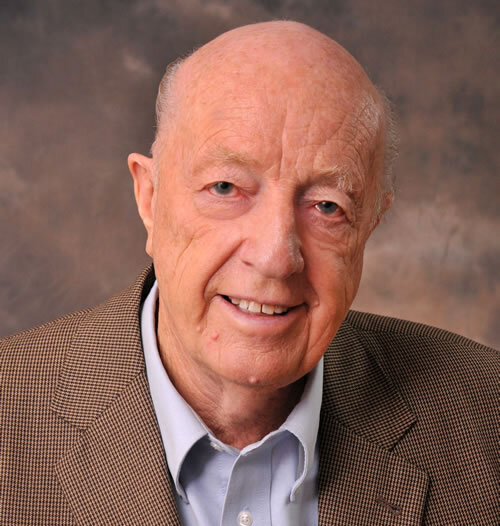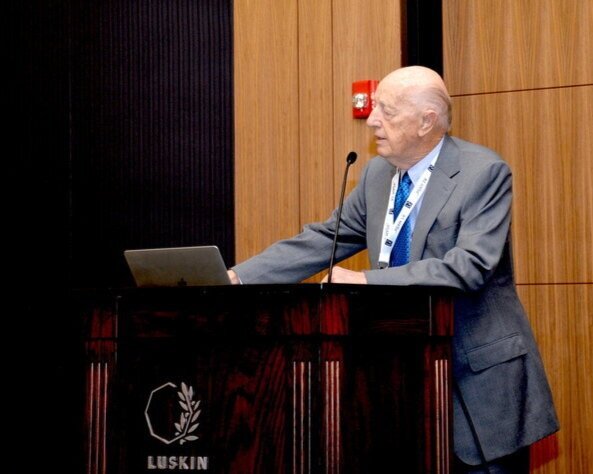In Memoriam: B. John Garrick, Pioneer in Development and Application of Risk Sciences
/Photo courtesy of the Garrick Family
B. John Garrick, the founder of the B. John Garrick Institute for the Risk Sciences, an international authority on Quantitative Risk Assessment, and a Distinguished Adjunct Professor of Materials Science and Engineering at UCLA passed away on Sunday, November 1st, at the age of 90, from complications due to a fall.
Garrick’s illustrious career spanned over seven decades and started with a government job in nuclear energy, followed by academic pursuits and private consulting, culminating in eight years of a presidential appointment as Chair of the U.S. Nuclear Waste Technical Review Board. He was a towering figure in the science and engineering community, especially on the application of the risk sciences to complex technological systems in the nuclear, space, defense, chemical, marine, and transportation fields.
In 2014, Garrick and his wife Amelia gifted UCLA Samueli $9 million to launch the B. John Garrick Institute for the Risk Sciences, an umbrella organization of multiple research centers at UCLA focusing on saving lives, and protecting the environment, property and infrastructure from large-scale, natural and man-made threats. “The complexity of risks to society and the environment has increased dramatically in the 20th and 21st centuries,” Garrick said in the announcement of the new institute. “We must meet the challenge of managing these threats with new thinking, methods, tools and applications. UCLA Engineering’s interdisciplinary approach to engineering and applied science, and its world-class faculty and commitment to public service make it the perfect home for the institute. I am thrilled to launch this exciting new enterprise to advance the risk sciences.”
Garrick Institute Dedication Ceremony, November 13, 2014. (Left to right: Amelia Garrick, B. John Garrick, Gene D. Block (UCLA Chancellor), Vijay Dhir (Former UCLA Dean of Engineering). Photo courtesy of the Garrick Family.
According to Ali Mosleh, UCLA’s Distinguished University Professor and founding director of the Garrick Institute, establishing the institute at UCLA reflected Garrick’s unparalleled dedication and commitment to the discipline of probabilistic risk assessment. “John Garrick was one of the founders and a global leader of the PRA discipline, and a formidable force in advancing the field in theory and practice,” Mosleh said. “Garrick was an active participant in many aspects of the institute and closely monitored the institute’s progress towards its stated vision and mission. While his passing marks the end of an era, his legacy will live through the work of those he mentored, particularly the new generation of researchers and educators at the academic institution he founded”.
Garrick received a B.S. in Physics from BYU in 1952. His first job after college was what he called a “bottom-of-the-grade” Physicist at the Idaho Chemical Processing Plant which has since become the U.S. Department of Energy’s Idaho National Laboratory. It was there that Garrick became interested in risk sciences, especially as they applied to nuclear energy. He attended the Oak Ridge School of Reactor Technology for a one-year, fast-track graduate course on nuclear energy. The school, which only operated for a few years, was affiliated with Oak Ridge National Lab with some of the country's best scientists in the field as instructors.
Following Oak Ridge, Garrick joined the U.S. Atomic Energy Commission in Washington D.C., working in a group that reviewed the safety of the nation's nuclear reactors. He left the commission for a job in Los Angeles at a small firm that provided engineering services to the nuclear energy industry. As his interests in risk sciences continued to grow, he decided to pursue advanced studies, receiving an M.S. in Nuclear Engineering from UCLA in 1962, followed by a Ph.D. in Engineering and Applied Sciences in 1968. His doctoral thesis titled, "Unified systems safety for nuclear power plants," laid out his theory on how to quantify risk — a concept later put into practice and one he continued to champion throughout his life.
After completing his doctorate, Garrick founded and led the first consulting firm of scientists and engineers, known as PLG, devoted to the development and application of quantitative risk assessment to both engineered and natural threats. The company conducted assessments for many of the nation's nuclear power plants, chemical plants, transportation systems, space systems and defense systems. PLG was acquired by another company in 1993 and Garrick retired from the firm in 1997. He continued to work as an independent consultant.
Garrick's monumental contributions to Quantitative Risk Assessment earned him wide respect and numerous awards. In 1981, Garrick and longtime collaborator Stan Kaplan published an influential and most cited paper in the journal Risk Analysis on the concepts of Probabilistic Risk Assessment titled, "On the quantitative assessment of risk." The paper formalized what is generally known as the risk triplet — What can go wrong? What is the likelihood of those events happening? And what are the consequences?
With other PRA Pioneers, Norman Rasmussen (L) and Stan Kaplan (R). Photo Courtesy of the Garrick Family.
Garrick was elected to the National Academy of Engineering (NAE) in 1993, one the highest honors bestowed on an American engineer for "making Quantitative Risk Assessment an applied science and a fundamental part of engineering design." He had been a member and chair of numerous National Research Council committees that examined space missions, automotive safety, the proliferation of nuclear materials and chemical weapons disposal. He was the Chair of the Committee on Combating Terrorism and served as Vice Chair and technical lead of the National Academy of Science’s Committee on Lessons Learned from the Fukushima Nuclear Accident for Improving Safety and Security of U.S. Nuclear Plants.
In September 2004, Garrick was appointed by President George W. Bush as Chairman of the U.S. Nuclear Waste Technical Review Board. He served two terms until September 2012. Garrick also served ten years (1994-2004), four years as Chair, on the U.S. Nuclear Regulatory Commission's Advisory Committee on Nuclear Waste. He served as the president of the Society for Risk Analysis from 1989 to 1990, and in 1994 received the society's most prestigious award, the Distinguished Achievement Award. In 2014, he received the UCLA Samueli Alumnus of the Year award. Garrick received the 2019 W. Bennett Lewis Award for Sustainable Energy and Development at the American Nuclear Society’s Winter Meeting in Washington, D.C. He was recognized for his contributions to the development of sustainable energy and for his lifelong leadership and efforts in the application of the risk sciences to complex nuclear systems.
Garrick was a fellow of three professional societies: the American Nuclear Society, the Society for Risk Analysis, and the Institute for the Advancement of Engineering. In addition to his academic position at UCLA as a Distinguished Adjunct Professor of Engineering, Garrick was also an Adjunct Professor at Vanderbilt University and a Lecturer at the Massachusetts Institute of Technology. At UCLA Samueli, Garrick was a member of the Dean's Executive Board and formerly the Dean's Advisory Council. He was also a member of the Leadership Council at the College of Physical and Mathematical Sciences at Brigham Young University.
As the Honorary Chair, Garrick gave opening remarks at the 13th International Conference on Probabilistic Safety Assessment and Management (PSAM) at UCLA, September 2018. GIRS photo archives.
A prolific writer, Garrick authored the book, “Quantifying and Controlling Catastrophic Risks” published by Academic Press; and was co-editor of the book, “The Analysis, Communication, and Perception of Risk” published by Plenum Press. He was also lead author of the handbook, “Power Plant Availability Engineering” published by the Electric Power Research Institute. In addition, he authored several book chapters and published more than 250 technical papers and reports on risk, reliability, engineering and technology.
Garrick welcomed guests from UCLA Engineering and Medicine Fundraising event at his residence, August 27, 2017. Photo courtesy of the Garrick Family.
Garrick is survived by his wife, Amelia Garrick; his sons, Robert and John; his daughter Ann Garrick Albertson; five grandchildren and seven great grandchildren. He was preceded in death by his parents, two brothers, and a sister.
B. JOHN GARRICK’S PROFESSIONAL FIRSTS
Member of startup team for the world’s first chemical reprocessing plant for highly enriched spent nuclear fuel. Part of the nuclear “criticality” physics team. The work was a major factor in the plant transitioning from batch mass limited dissolvers to “criticality” safe continuous dissolvers. (U.S. Atomic Energy Commission’s National Reactor Testing station, Idaho, 1952-1954)
First employee of the AEC’s Idaho site to attend the Oak Ridge School of Reactor Technology as a Category A student, the premier nuclear reactor engineering training center during the early years of the nuclear era when most of the curriculum was still classified (1940s to the 1950s). (1954-55)
As a young physicist in the USAEC’s Reactor Hazards Evaluation Staff in the General Manager’s Office, was first liaison representative between the AEC Reactor Hazards Evaluation Staff and the Naval Reactors Branch of the Division of Reactor Development as well as the Advisory Committee on Reactor Safeguards. (1955-57)
Principal technical reviewer for the USAEC’s issuance of its first commercial license for a civilian nuclear reactor. (General Electric’s Vallecitos Valley Boiling Water Reactor, Vallecitos, Valley, California, 1956-1957)
First PhD thesis in U.S. on a probabilistic approach for assessing the safety of nuclear power plants. (UCLA, 1968)
Founded first consulting firm, PLG, Inc., exclusively devoted to developing and applying probabilistic risk assessments (PRA) to complex engineered and natural systems, first to nuclear power plants and later to technological and natural systems in general. (1975)
Director of PRAs that first introduced Bayesian methods for processing supporting evidence for nuclear plant risk assessments. PLG scientist Stan Kaplan led the effort. (1978-1981)
Director of the first utility sponsored probabilistic risk assessment of a U.S. commercial nuclear power plant, the Oyster Creek Nuclear Power Plant. (1976)
In support of the Oyster Creek PRA, put together a team to develop the first seismic risk curve, the foundation for designing earthquake tolerant nuclear power plants. The Oyster Creek PRA was the first to formally integrate external events into the initiating event vector. (1977-1979)
Study director of the first nuclear utility sponsored commercial full scope probabilistic risk assessments (plant, containment, site) that included development of the first containment event trees. First risk assessments to propagate uncertainties through the model to quantify the analysis uncertainties and developed and put into practice the triplet definition of risk” following the seminal Rasmussen report (the Reactor Safety Study, WASH-1400) that changed the landscape of nuclear safety analysis. The triplet definition of risk was first applied in the Zion/Indian Point risk assessments 1980-1982 and has become part of the regulatory framework.
Either as project director, principal investigator, or member of the team, participated in the preparation of some 40 first-of-a-kind major risk studies of nuclear power plants performed by PLG during the period 1977-1992. Each report contained new advances in methods of analysis.
Director of the team to first apply proof of concept PRA methods to the Space Shuttle program. (NASA, Johnson Space Center, 1986)
Director of the team to perform the first comprehensive quantitative risk assessment of a commercial nuclear waste storage facility. (NYSERDA, 2009)
Founder of first research university institute devoted exclusively to the quantitative risk sciences. (UCLA B. John Garrick Institute for the Risk Sciences, 2014)
Lead author on first Garrick Institute report: Taking Action to Prepare for Catastrophic Risks. (UCLA, 2015)
Organized First UCLA International Colloquium on Catastrophic and Existential Risk. (UCLA, 2017)
Organized first UCLA workshop on Quantifying Global Catastrophic Risks.(UCLA, 2018)








